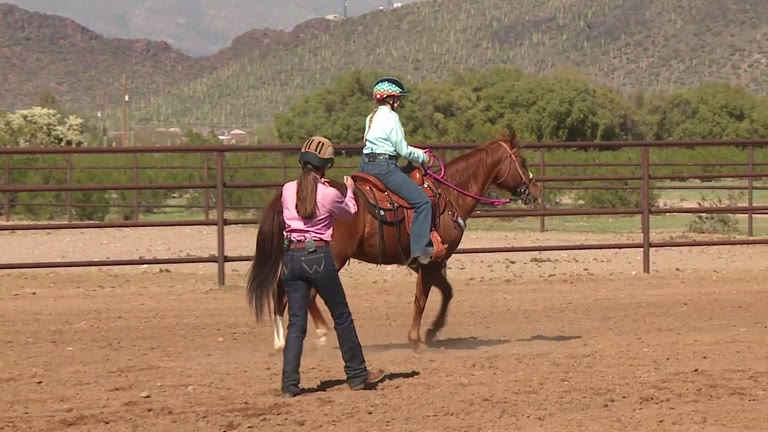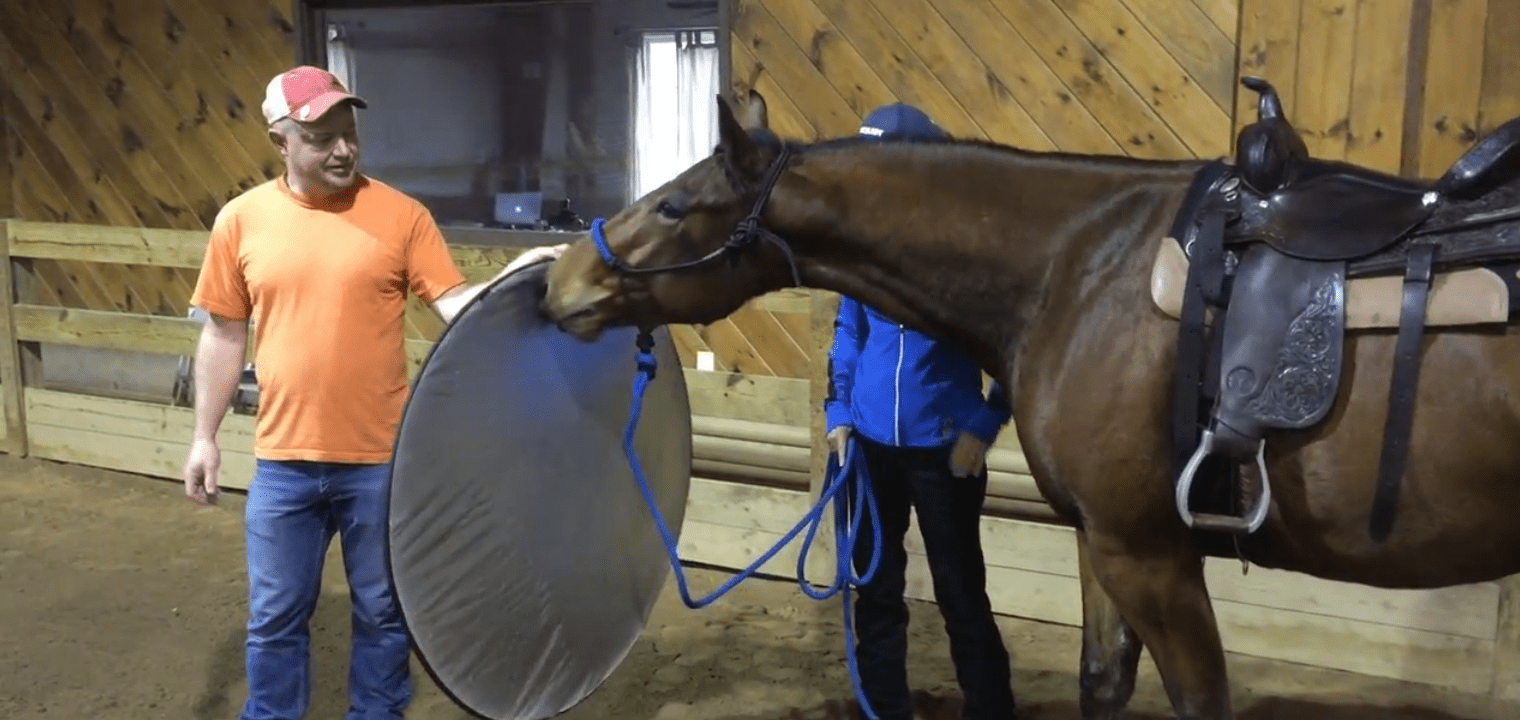Question Category: Issues from the Saddle
Question: Dear Ms. Goodnight,
I have a 15-year-old quarter horse, MAX, who decided he does not want to be the second horse out on the trail. I ride alone most of the time but do enjoy the company of others. When he feels any competition from another horse he starts to arch his neck sets his head. He is not on the bit at all. After he gets mad enough he just hoops once and then rears. This can happen so fast I don’t see it coming until he is up. He is getting very good at rearing. I have been trying some things like another horse being in the lead, Max and I going by the first horse and stopping letting the second horse become the first, as soon as he gets “excited” I ask him to go away from the first horse, as soon as his direction is to the other horse he starts with the neck, head and the rear is very soon to come. How do you feel about tie-downs? Any suggestions besides don’t ride with others or be the lead horse all the time, those are some answers I have been given. Thank you in advance,
Ruth from Pennsylvania
Answer: Ruth,
This is not a matter of your horse rearing or whether or not you can ride with others, but a serious indication that your horse is dominant (over you and the other horses), aggressive and inadequately trained. A horse this out-of-control is dangerous to you and those you ride with. It is certainly not an issue that a tie-down would resolve, since these behavior problems are related to dominance and herd behavior, not raising his head (head raising and rearing are symptoms not the cause of the problem).
Just for the record, there is no situation in which I would use a tie-down on a horse to resolve a training problem because in this application it simply masks the symptoms of the horse’s problems and can get in the way of a horse’s natural carriage and balance. A tie-down is particularly dangerous in the event of a rearing horse because the horse is more likely to lose his balance and fall over when he rears.
Your horse needs to learn, right here, right now, in no uncertain terms, that this aggressive, herding and dominant behavior is absolutely intolerable when he is undersaddle or in the presence of humans. Any transgression should be met with the harshest correction; the punishment should fit the crime and the more aggressively your horse behaves, the harsher the punishment.
Always in horse training, you have to apply enough pressure to the horse to motivate him to change. In the case of your horse, because he is acting abnormally aggressive, it will likely take a lot of pressure to gets his attention and motivate him to change. Based on the history you have with this horse, it is questionable whether or not you will be assertive enough or in control enough to motivate this horse to change his behavior. In capable hands, this horse could be taught to mind his manners and be obedient in a short amount of time; you may want to consider taking this horse to a qualified trainer.
The behaviors you are describing are all natural herd behaviors. Your horse wishes to be in front because that is where the alpha horse should be and he is intolerant of any subordinate who dares to get in front. He is arching his neck in a display of might, in a prideful manner. It is a warning to “his” subordinates, along with the squealing, that he is about to become aggressive, should they persist in their insubordinance.
Horses have three weapons in their personal arsenal when they choose to become aggressive or combative: bite, strike, and kick. Your horse is displaying threatening gestures with all three weapons. The rear is the threat to strike and the whirl is the threat to kick; horses make biting gestures with their head and mouth making snaking or herding gestures. There is lots of information on my website about these behaviors.
Young horses should be taught at an early age that they may not act impulsively and interaction with other horses is not acceptable when being handled and ridden. They can act however they want when out in the herd, but once a human has haltered them and brought them in to work, they should refrain from displays of herd behavior and interacting with other horses in any way, even rubbing noses. This fundamental expectation should be strictly enforced at all times whether you are riding alone or in the company of others. Clearly your horse thinks he’s dominant and does not think of you as the herd leader, or he would never act this way. There is no quick fix to repair the relationship between you and your horse. You will have to work at it by doing ground work and changing your impression to the horse both on the ground and in the saddle. I have DVDs on this type of relationship building with the horse: Round Pen Reasoning and Lead Line Leadership (order online or at 800-225-8827).
Your horse must learn that there is certain behavior that is simply not tolerated while under saddle, specifically displays of aggression and herding behaviors. My expectations of any horse I ride would be even greater: no fraternization at all with other horses and its nose must remain right in front of its chest and it must maintain the path and speed that I have dictated. There should only be one conversation between you and the horse, “This is your Captain speaking.” Any deviance to the expected rules of behavior should be met with immediate correction (within less than three seconds, preferably less than one second). The best way to correct a horse is to “make the right thing easy and the wrong thing hard.” You have already touched on this concept, but not effectively.
Remember, the pressure you put on the horse should be no more and no less than the pressure required to motivate him to change. If it is not enough pressure, he will continue the unwanted behavior (all the while learning to ignore and disobey your commands). If it is enough pressure to motivate him to change, he will then immediately look for a way out of the pressure. As soon as he finds the right answer, he gets an immediate and welcomed release and life gets easier. Comfort and security are the two greatest motivating factors for horses. It is always best if the motivating factors are something that comes naturally to the horse. Therefore, one of the greatest motivating stimuli for horses doing something you perceive as wrong is to make them work hard and remove companionship. The release (reward) is letting the horse rest and be with the herd. Thus the hard thing is work and isolation, the easy thing is rest and companionship (comfort and security).
While you are out on the trail, anytime your horse even hints that he is concerned about another horse in the group, you should immediately take him away from the herd and put him to hard work (turn, circle, change speeds, lope circles, go-stop-go; possibly until he is dripping in sweat the first few times). When he becomes obedient and responsive to you, let him rest and come back to the herd. When and if he becomes aggressive again, immediately take him away and put him to work again. Repeat this process until the horse makes an association between his behavior and the negative stimuli. Depending on how effective your timing is (both with the correction and the reward), he may make the association the first time or it may take dozens of times. Remember, there is an old axiom about horse training that says, “It always gets worse before it gets better.” Since your horse has been displaying dominant and aggressive behavior, chances are he will not easily be dissuaded from his bad behavior and he may challenge your authority and control to an even greater degree. Therefore, be very careful and make sure you are up to the task. If you have any doubt about your ability to get the job done without a greater risk of getting hurt, consider enlisting a professional to help retrain your horse and teach him some manners.
JG
Copyright ©Julie Goodnight 2000. All Rights Reserved. No part of this website may be reproduced without owner’s express consent.
Keywords: In Front on the Trail, Front on the Trail



